48 Hour Dublin, Ireland Itinerary: A Guide to the Irish Heartbeat
By Daniella from Sampler Platter Travel – this guide to Dublin contains affiliate links to trusted partners!
Don’t have a lot of time to explore Dublin, Ireland? Welcome to your new favorite 48 hour Dublin, Ireland itinerary, perfect for travelers who love to walk a lot and explore all the must-see sites in a short amount of time.
In this itinerary, I will help you prioritize things to see in Dublin if you only have 2 days. Thanks to the compact nature of the city, most highlights are within walking distance from each other, so you can stretch your legs and explore picturesque city parks, awe-inspiring cathedrals, and get to know Ireland’s fantastic beer.
My mom and I traveled to Dublin last year, and even though they still had Covid-19 precautions in place, we greatly enjoyed our time in the city. From down-to-earth locals to hearty meals and Viking-era constructions, there’s something for everyone in the quirky capital of Ireland.
Dublin makes a fantastic add-on to your exploration of Northern Europe, including a quick 3-Day trip to London, England. Happy sampling!

Table of Contents
Day One – a Victorian Park, a University, & a Stroll Around the City Centre
On day one of our 48 hour Dublin, Ireland itinerary, we are going to explore a relaxing park, a bustling shopping street, an incredibly old university with an even older manuscript, an emigration museum, and a lively pub district.
(1) Stephen’s Green
Start your day with a beautiful walk through St. Stephen’s Green to get some fresh air. Located right in the heart of Dublin’s city centre, St. Stephen’s Green is a Victorian park that feels like it came out of a movie. Its 22 acres contain ornamental ponds, luscious shrubbery, and well-maintained lawns. If you are a fan of swans, you will find one at every turn in St. Stephen’s Green. On the other hand, it is perhaps not the best location for people who are afraid of birds.
Founded in 1664, the park is shaped like a rectangle and is located in what used to be the city’s outskirts. Lucky for us modern travelers, it is now the city’s heart, where stunning Georgian-style houses surround the park. The most unique part of the park is a garden for the blind, complete with strong-smelling plants and labels in braille.
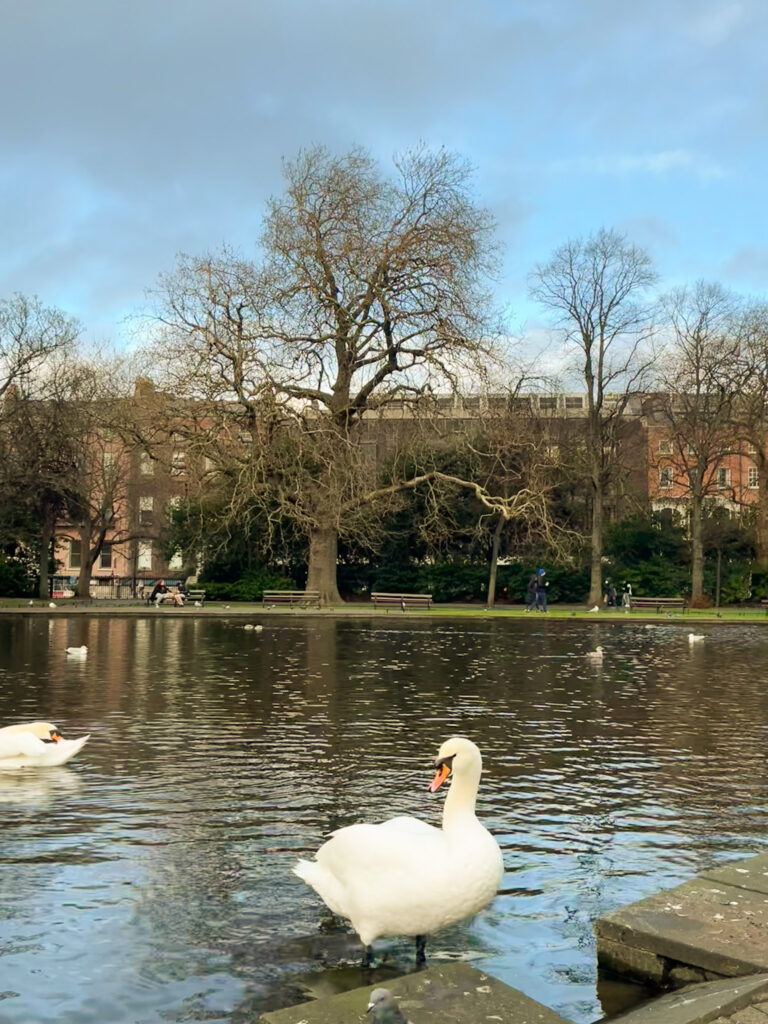
(2) Grafton Street
Hopefully, you enjoyed a nice relaxing walk through St. Stephen’s Green, as we are going to take it up a notch energy-wise and head to one of Dublin’s most busy and important commercial streets: Grafton Street. Grafton Street is self-proclaimed as one of the busiest shopping streets in all of Europe, and it is pedestrian-only. From the Disney store to cafes, restaurants, bars, and top-notch hotels, Grafton Street is worth a stroll down. It is right on the edge of St. Stephen’s Green, and if you have any shopping you’d like to get done, this is the best place to do it.
Grafton Street is also well-known for having frequent street performers lining the way, so there is certainly no shortage of events and electricity. Fans of Ed Sheeran’s song Galway Girl will recognize the line “I met her on Grafton street right outside of the bar” – this is one of the most happening streets in all of Dublin!
(3) Trinity College & Old Library & Book of Kells
After getting your fix of shopping or eating, take an easy five-minute walk from Grafton Street to arrive at the historic gates of Trinity College. Founded in 1592, this incredibly impressive university boasts neoclassical architecture and manicured lawns. It is the sole college of the University of Dublin, and the campus will make your jaw drop. Take some time to wander around the property and admire the student buildings from the outside. Even though the campus is gated, you will have access to a grand majority of the outdoor space.
Finally, head to the Old Library, the home of the Book of Kells. The library will transport you back in time to the 18th century, and the Book of Kells will take you to the 9th. This Celtic Gospel manuscript was written in Latin in Ireland or Scotland and holds the title of the most famous medieval manuscript in the world.
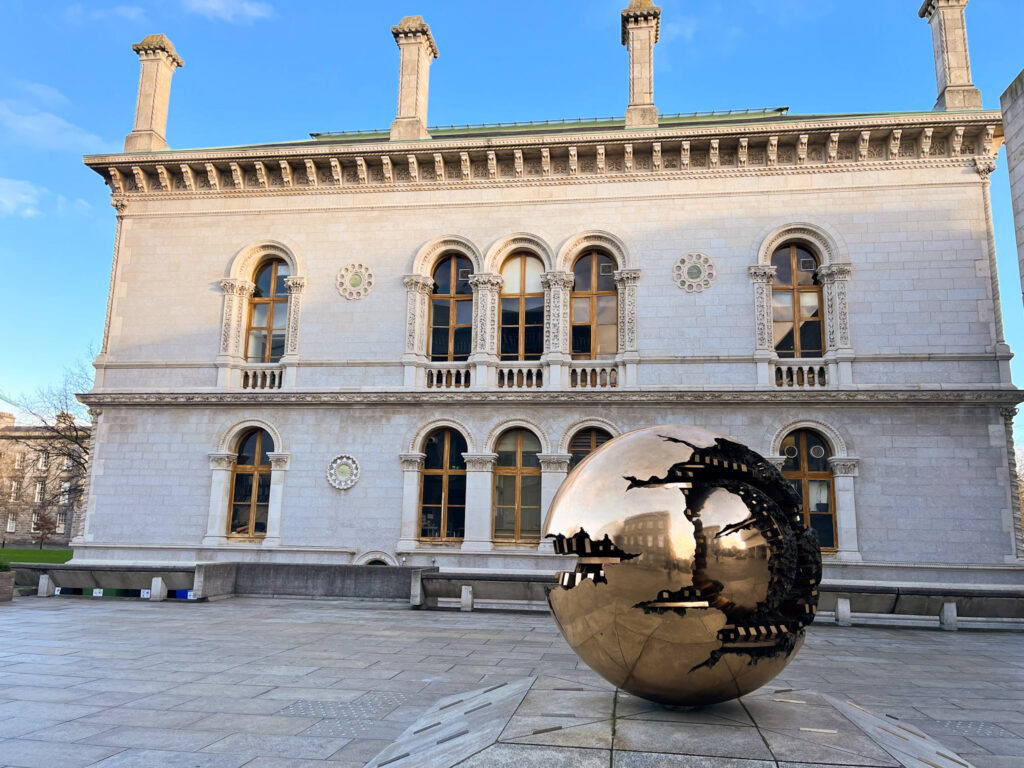
The manuscript is on display in a separate exhibition with related texts, but don’t forget to head upstairs to check out the Long Room. Here, you can see the 200,000 oldest books housed in the library within oak bookcases. If this sounds like an impossible number to wrap your head around – it is. Expect to see lots and lots of books.
Viator leads a great tour of Trinity College and the Book of Kells, where you can learn about the history of the university instead of just wandering and taking a few guesses. Plus, when my mom and I tried to enter the Old Library, we happened to arrive on the one day of the year when they were closed for maintenance. Therefore, having an organized tour group can certainly help make sure these things don’t happen.
(4) EPIC The Irish Emigration Museum
Now here’s a museum I’ve never seen on lists of Dublin ‘things to do’, but I will say that my mom and I greatly enjoyed it. EPIC The Irish Emigration Museum takes you through the reasons why 10 million people have left Ireland and the impact they have had all over the world.
The museum does a fantastic job of having immersive exhibits that transport you back in time to when emigrants started leaving Ireland, all the way to the present day, where you can see everything that Irish descendants have accomplished around the world. The museum even showcases prominent historical and political figures that you didn’t realize were Irish and guides you through the hopes and promises of the Irish people.
While it certainly isn’t a “traditional” museum with artifacts and old sculptures, the EPIC museum is worth a visit. Adult tickets cost 20 euros, and expect to spend about 2 hours in the museum.
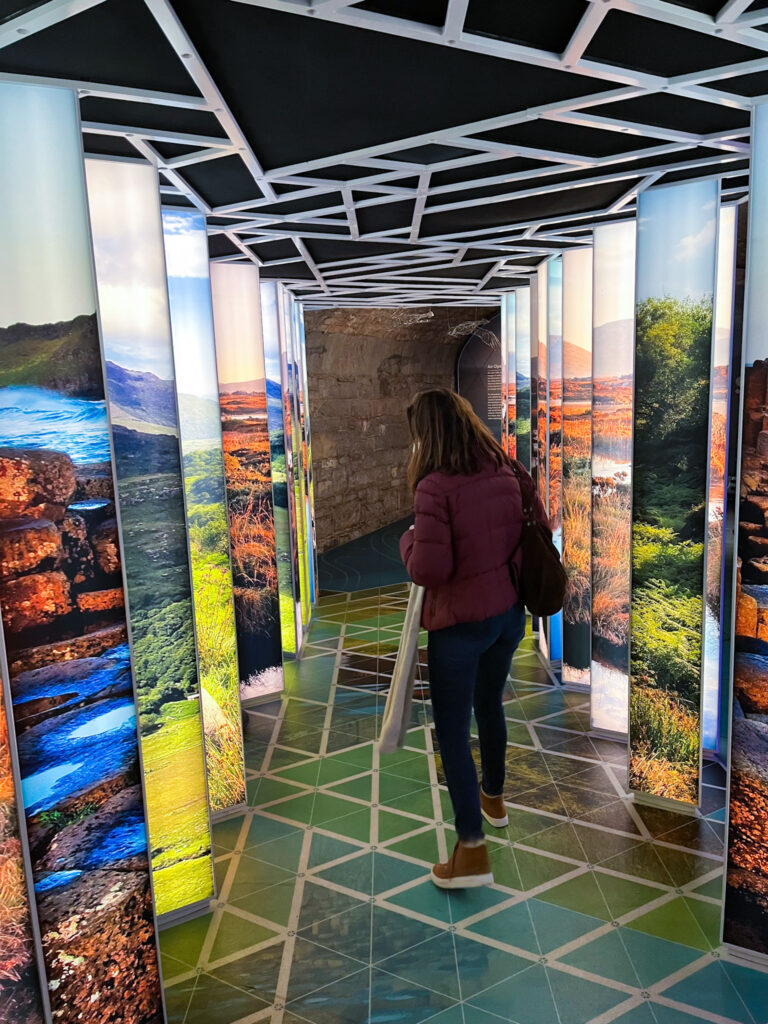
(5) Ha’Penny Bridge
On your way back to Dublin’s City Centre from the Docklands (the location of the EPIC museum), wait to cross the River Liffey until you reach the Ha’penny Bridge. This pedestrian bridge is said to be one of the earliest cast-iron bridges in the world as it was built in 1816. The name comes from the fact that it used to cost visitors half a penny in toll money to cross the bridge.
Now, lucky for us, it is a free attraction that offers great views of the River Liffey, taking you from the North Quays side of the river right down to the Temple Bar neighborhood. It was the only pedestrian bridge over the River Liffey until the Millennium Bridge was built in 1999, but that one is less fun to cross over.
(6) Temple Bar Pub or the Brazen Head
On the other side of Ha’Penny Bridge, you’ll find the famous Temple Bar neighborhood. This pedestrian-only area with cobblestoned streets is the home of multiple pubs, live music venues, and restaurants. There is a young and hip heartbeat in this area.
One famous pub to try out is the Temple Bar Pub. The phrasing is definitely confusing as Temple Bar is the neighborhood while the Temple Bar Pub is the bar itself! The pub boasts live traditional Irish music every day and an insane whiskey and beer selection. It also has a famous façade, known for its fun lights and red paint. Temple Bar Pub is incredibly crowded most of the time, so if you don’t fancy waiting or dining with a loud crowd, say hello to the bar from the outside and keep walking for a quieter dinner spot.
For another famous establishment, head to the Brazen Head, self-proclaimed as Ireland’s oldest pub. The Brazen Head is also not for the faint of heart, as there is live music every evening and the restaurant is lit with lanterns at night. However, for a famous Dublin pub experience, try the Brazen Head or the Temple Bar Pub. For a more relaxing dinner, head out of the Temple Bar area altogether.
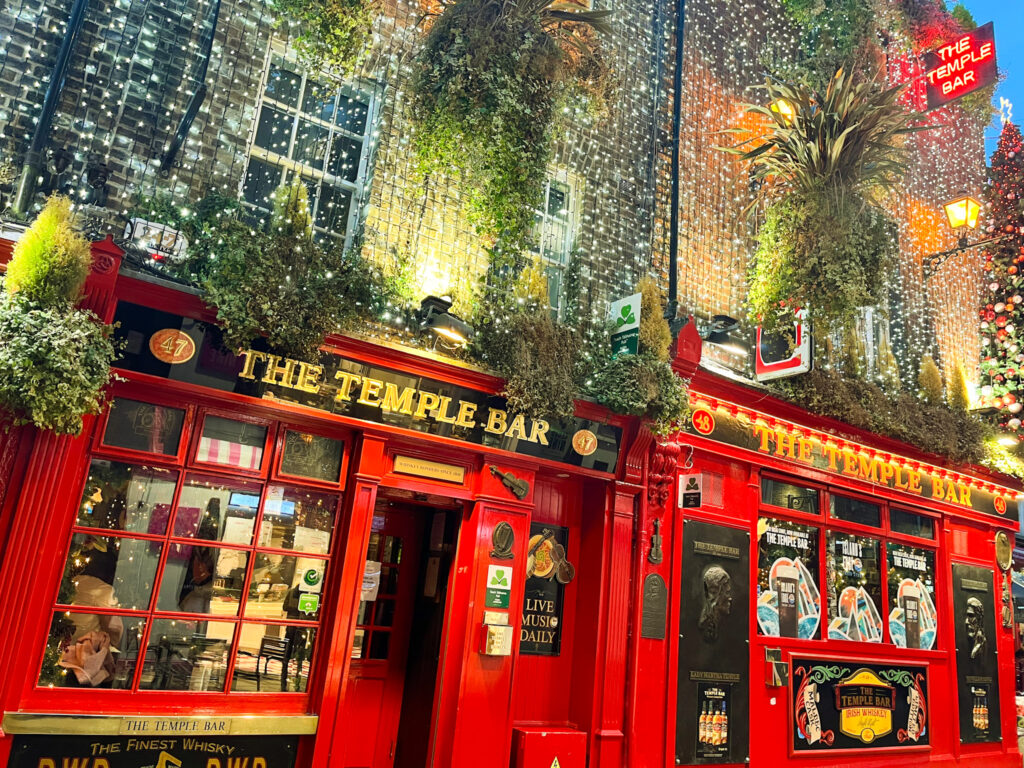
Day Two – Cathedrals, Castles, An Old Jail, & Guinness
Day two is all about walking westwards, stopping to see sites along the way. Discover the old and unique history of Dublin before ending the day by treating yourself to a hearty Guinness – who needs to eat dinner when you can have a dark stout?
(7) St. Patrick’s Cathedral
Start today’s tour by admiring St. Patrick’s, a Roman Catholic cathedral founded in 1191. It sits on an impressive green lawn and is one of two medieval churches in the city of Dublin. We will visit the second cathedral on the 4th stop of the day. If you are like me and enjoy walking and viewing historical buildings from the outside, the day will pass by rather quickly, but if you enjoy going into buildings, then get ready for a busy day! You might even want to return in the evening to see St. Patrick’s Cathedral lit up at night.
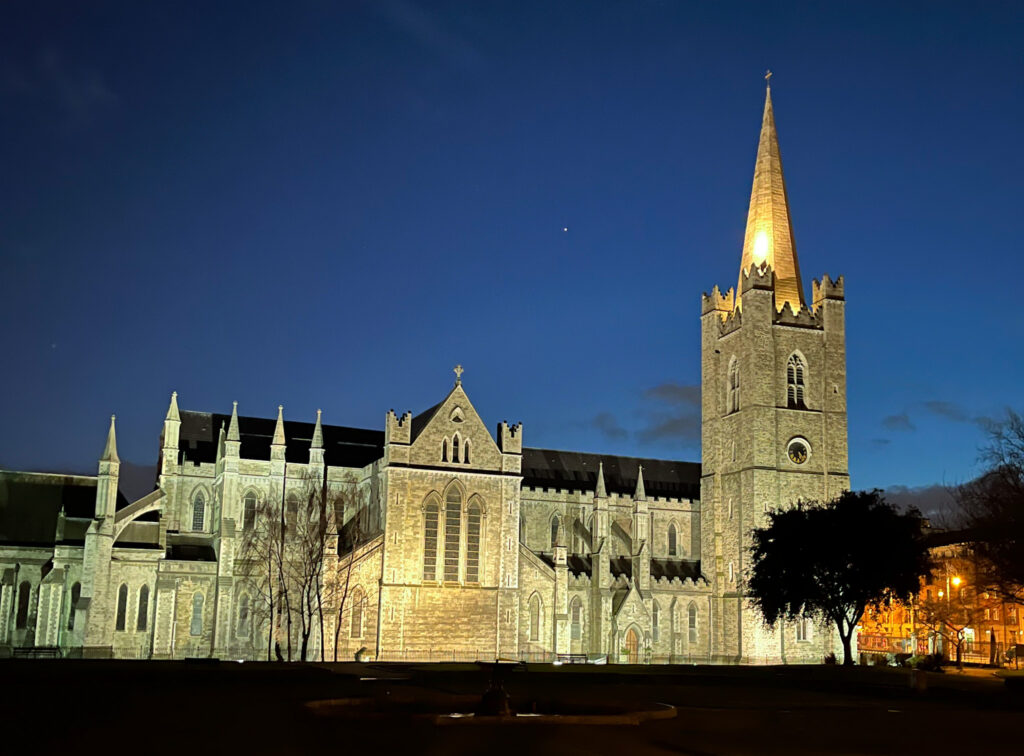
(8) Dublin Castle
From St. Patrick’s Cathedral, walk around 12 minutes to get to Dublin Castle. The Dublin Castle is a building from the early 13th century that was built on a Viking settlement. It was the headquarters for the British administration until 1922 when Ireland became independent. Now, Dublin Castle belongs to the Irish government, serving as an important complex. It houses two museums and a picturesque Dubh Linn Garden that is worth a wander through.
Unless you are a big fan of the interiors of historical buildings, we don’t think going in is very worth it. The main attraction is seeing the castle from the outside, as some of the façades have fun colored paint. My mom and I were incredibly curious about the paint color, and while I have racked the internet trying to find a reason for them, I have found nothing. So, please reach out to me if you know why the Dublin Castle has bright primary color paint. I’m dying to know the answer.
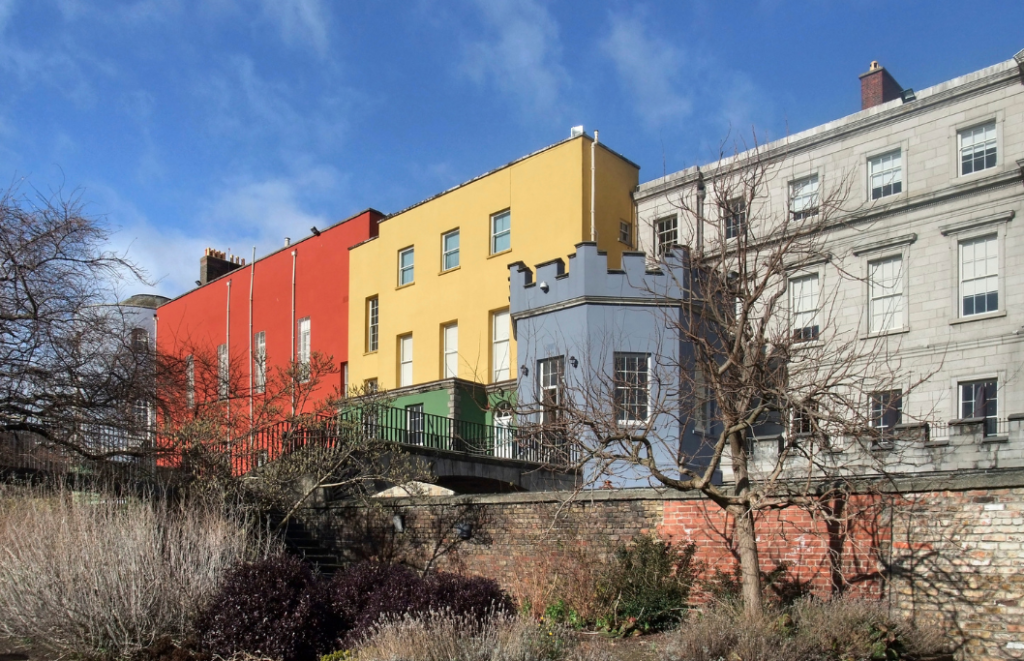
(9) Chester Beatty Library
Located on the Western edge of the Dubh Linn Garden, the Chester Beatty Library is a museum within the same complex as the Dublin Castle. It was established in 1953 on the site of the private library belonging to Sir Alfred Chester Beatty, a mining engineer and collector, hence the massive amounts of artifacts.
Admission to this museum is free and holds relics and ancient manuscripts from Europe, the Middle East, North Africa, and Asia. It is certainly worth a visit to see the many exhibitions. For more information on permanent and rotating collections, check out the Chester Beatty website (not an affiliate link).
(10) Christ Church Cathedral
The Cathedral of the Holy Trinity, also known as Christ Church Cathedral, is a beautiful stop along your walk towards the western end of Dublin. Located just a 4-minute walk away from Dublin Castle, this thousand-year-old cathedral is an absolute marvel. Of the two medieval cathedrals in the city of Dublin, Christ Church is older as it was founded in the 11th century by a Viking king. Talk about old history!
(11) Kilmainham Gaol
From Christ Church Cathedral, take a taxi or stretch your legs for a 40-minute walk to Kilmainham Gaol. This former prison in Dublin is a jaw-dropping museum currently run by the government. With quite a jaded history, Irish revolutionaries were imprisoned and sometimes executed after the rebellions of 1798, 1803, 1848, 1867, and most recently, after the 1916 Easter Rising by the British government.
We highly suggest visiting thanks to its immersive experience and well-guided tour of the preserved jail, where thousands of men, women, and children were housed for over 100 years. To visit the jail, you must take a guided tour, which lasts one hour. It truly is a heart-wrenching experience but is worth it to learn about the history.
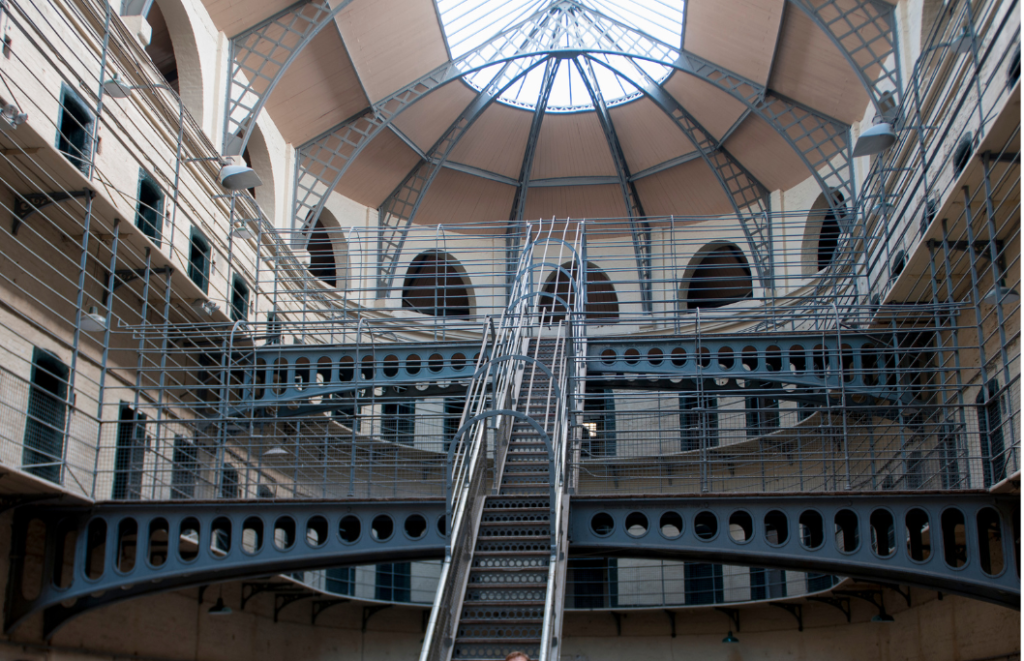
(12) Guinness Storehouse
After that cheery experience (please note the sarcasm), head over to the Guinness Storehouse, the most immersive brewery that you will ever visit. The self-guided brewery experience takes approximately 90 minutes to complete and very creatively leads you through the brewing process. By the end, you will feel as though you have been made into beer.
Think 90 minutes is too long to learn about beer? Think again, as it will go by in a flash. At the end of the museum, head up to the rooftop for amazing panoramic views of Dublin and a chance to try a bunch of different types of Guinness beers. I am not a lover of stouts or dark beers but will say that Guinness is fantastic.
That wraps up the list of 12 things to do in a 48 hour Dublin, Ireland itinerary! For more information on what to eat, where to stay, how to get around, and extra day trips to take if you’ve fallen in love with Dublin, read further!
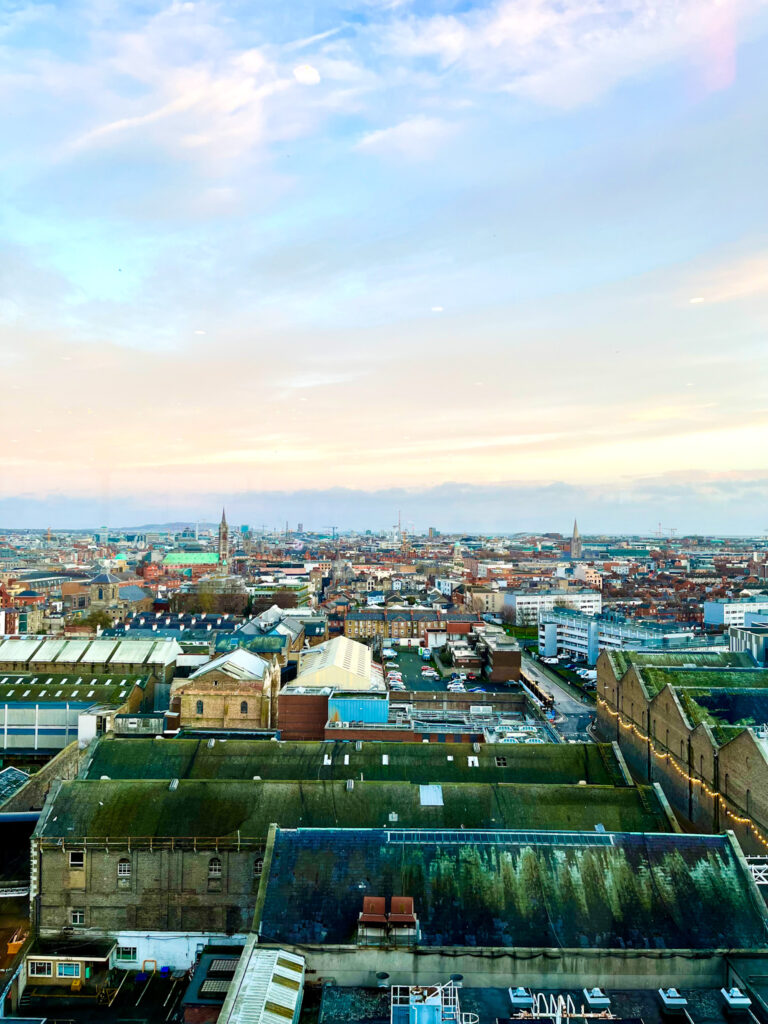
Food to Try in Dublin
Apart from the obvious Guinness beer mentioned above, there are a few more food items that you certainly must try on your trip to Dublin.
-
Irish Whiskey
For travelers who drink, make sure to get at least one Irish Whiskey drink or cocktail during your stay in Dublin. Irish Whiskey is famous for being made with malted as well as unmalted barley, distilled three times to create a smooth and pure alcohol. Even if you aren’t a traditional fan of whiskey and think it tastes like turpentine, you will discover the beauty in the gentle nature of Irish Whiskey. And if you don’t like sipping it on the rocks, feel free to hide some of the alcoholic taste in an Irish Mule.
-
Traditional Irish Breakfast
A perfect option for budget travelers! You won’t need to spend money on lunch after indulging in a traditional Irish breakfast. This full platter includes bacon, sausage, potatoes, eggs, tomatoes, toast, beans, mushrooms, and black pudding. It is a meat and starch lovers paradise for a strong start to your day. While you may think that black pudding refers to chocolate pudding or another dessert, this particular pudding is made from pork blood sausage while white pudding (which occasionally makes an appearance in these breakfasts), is similar to black pudding except without the blood.
-
Boxty Pancakes
Not a fan of all the mentions of blood and meat above? Well, vegetarians will much prefer the boxty pancake option, made from Irish potatoes. The potatoes are finely grated and fried to create a pancake-like consistency and usually topped with scallions and cream. It works as breakfast, lunch, and dinner.
-
Coddle Stew
Coddle is a dish that is traditionally made at home using leftovers. Most commonly, the stew contains sausages, potatoes, and onions. Coddle is available in most pubs as it is associated with Dublin and is frequently served with bread on the side. Don’t forget to get a pint of Guinness to add to your already-hearty stew.
-
Irish Coffee
The Irish know how to start the day correctly! This drink is both caffeinated and alcoholic, which makes it a perfect combination. Here, hot coffee is mixed with sugar and Irish whiskey and topped with cream. If you’re on vacation, why not have one with your breakfast? Most cafes and pubs in Dublin will serve a form of this alcoholic coffee drink.



Where to Stay in Dublin
Since Dublin is a relatively compact city with main sites located in the same general vicinity, any location within the City Centre is a perfect place to stay.
- For travelers with a higher budget, I greatly recommend the Fitzwilliam Hotel Dublin (no affiliate link). It is incredibly down-to-earth and friendly while remaining luxurious. Its location on the edge of St. Stephen’s Green and Grafton Street is fantastic, and I could not recommend it more.
- For budget travelers, check out the following three favorite hostel options:
- Jacobs Inn – located near Dublin’s main bus station, this hostel is perfect for travelers exploring the rest of Ireland. This clean location has the option for private bathrooms as well as dorm beds with individual curtains for maximum privacy.
- Clink i Lár– right on the North Quays side of River Liffey, Clink i Lár is located a two-minute walk from Ha’penny Bridge and provides easy accessibility to the Temple Bar neighborhood. This modern hostel has fantastic communal spaces as well as clean, well-maintained dorm rooms.
- Abbey Court – the Abbey Court hostel is located near Clink i Lár, also giving it a prime location to the major sites of Dublin. Abbey Court has great facilities including a cinema room, games room, and a large kitchen for those staying longer.
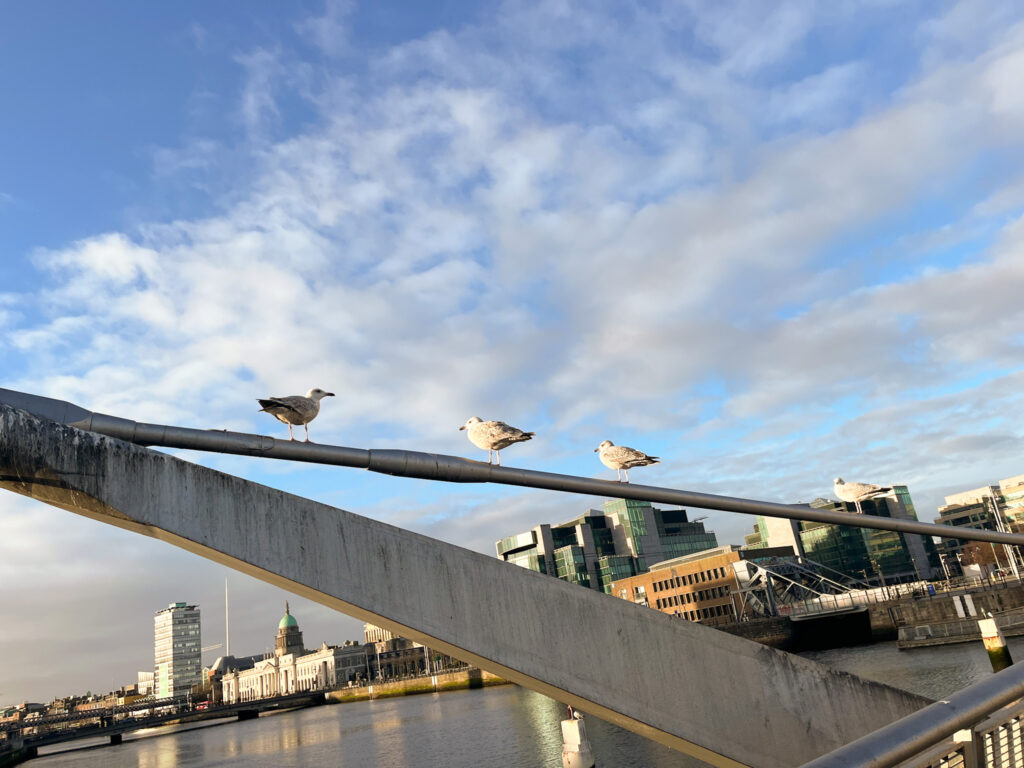
How to Get Around Dublin
Dublin is a super walkable city, and this 48 hour itinerary has been organized to maximize things to see on foot efficiently. For some of the farther stops like the Kilmainham Gaol, if you aren’t interested in walking over 40 minutes, take a taxi as they are relatively affordable in the area.
The Dublin Airport is located pretty far from the City Centre, so when coming into Dublin, make sure to take a local taxi. It takes approximately 45 minutes with traffic to get from the airport to Grafton Street (a good marker of the center), but apart from going to and from the airport, you’ll find that the main sites in Dublin are in a pretty compact area so you won’t have trouble walking or taking the occasional taxi. Furthermore, buses run frequently and efficiently in Dublin.
Day Trips and Add-Ons to Your 48 Hour Dublin, Ireland Itinerary
-
Howth Cliff Walk
Take a road trip outside the center of Dublin to explore Howth, a charming seaside fishing village with fantastic hiking options along its cliffs. Located 1 hour away by car, the best way to get to Howth is by taking the DART train from Tara Street Station. These trains leave every half hour and only take around 30 minutes to get to the town. Explore Howth on your own or take a 3-hour tour to learn about the history of Howth Castle, St. Mary’s Abbey, and end the day with a hike along the scenic cliff path loop.
-
Take a Walking Food Tour
What better way to learn about a city than through its food? As we’ve already discussed, there are so many wonderful dishes that you must try during your time in Dublin. If you fancy a guide to help you find the best authentic pubs, markets, and more, check out this tour with Secret Food Tours. They keep it small and cozy with a group of 12. On top of finding the best food in the city, you’ll also experience the major landmarks of Trinity College and the Guinness Storehouse during a 3.5-hour tour.
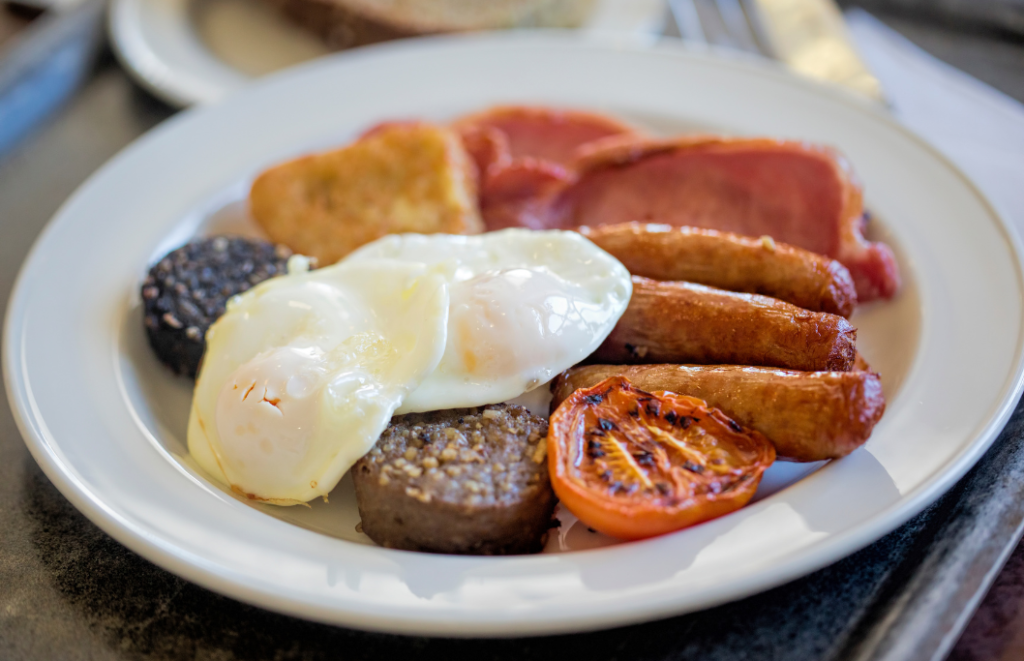
-
Belfast and Giant’s Causeway Day-Trip from Dublin
For adventurous travelers looking to go a lot further in one day, consider taking a tour of the Titanic Experience in Belfast as well as the Giant’s Causeway in Northern Ireland. In this full-day experience lasting 13 hours, rise early for a 2-hour coach trip to Belfast, wander through the Titanic Museum (one of the best museums I’ve ever visited), and check out the UNESCO World Heritage Site of the Giant’s Causeway, a natural area of basalt columns created by volcanic fissure eruption. It is a long day, but if you want to get a taste of Belfast without the hassle of renting a car, it is a great tour to check out.
-
Cliffs of Moher
Another tour for ambitious travelers! Starting at 6 am and ending at 8 pm, this full-day tour takes visitors from Dublin to the west of the country by coach. Marvel at the Cliffs of Moher for 2 hours, see Burren National Park, and pass by other notable roadside stops such as Dungaire Castle, Bunratty Castle, and Folk Park. End the day by walking around the city of Galway before returning to your Dublin hotel. Once again, another great reference for lovers of Ed Sheeran and his song, Galway Girl.
Unsure about the Cliffs of Moher? We had a great time seeing the area with sea cliffs, stunning sights, and incredible green grass everywhere. There are paved pathways that allow you to catch the views without getting dangerously close to the edge. And don’t forget to leave your baseball cap at home – winds near the Cliffs of Moher get insanely strong! Read about our Day Trip to the Cliffs of Moher from Dublin.

Frequently Asked Questions About a 48 Hour Dublin, Ireland Itinerary
Can you do Dublin in 2 days?
Yes, you can certainly experience Dublin in 2 days. The main city sites are within the same general area, so walking around will allow you to see most of what Dublin has to offer. Of course, if you want to get to know where the locals hang out and explore the outskirts of the city, you may want to add an extra day to your itinerary. Regardless, Dublin makes for a perfect weekend trip, and you will be able to see the major sites in 48 hours.
Is it worth going to Ireland for 2 days?
It is certainly worth going to Ireland for 2 days if you are only interested in exploring Dublin. Dublin makes a great quick weekend trip from the United Kingdom or mainland Europe, where flights are under two hours. However, to see the Irish countryside, Galway, the Cliffs of Moher, Cork, or wander up to Northern Ireland, it is best to add more days to your itinerary to ensure that you get a good taste of what the country has to offer.
What is the best way to see Dublin in just a few days?
The best way to see Dublin in just a few days is to walk! Dublin is a compact city, and with a well-planned itinerary (like this one ?), you can hit your must-see spots effectively and efficiently. Dublin does have a good bus system as well as well-priced taxis. Therefore, if you get tired of walking around, you certainly won’t get stranded.
I hope you enjoyed this fast-paced and walkable 48 hour Dublin, Ireland itinerary. It was tested and loved by my mom and me during our trip in January of last year, where we greatly enjoyed being able to walk everywhere and see the major sites of Ireland’s medieval and eclectic capital city. Dublin is a great addition to your trip to London as well as mainland Europe, so don’t forget to check out our other European Travel Guides.
Happy Sampling!

